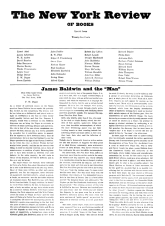Edward Albee’s first four plays were remarkable for an unusual ability to imagine and develop a dialogue that was both realistic and absurd: true to life, that is. At the same time, the playwright did not seem to know what to do with the situations he had created, except to end them with some abruptly introduced trick. In the Zoo Story, for example, the meeting between the tramp and the well-paid intellectual unfolds for a while with all the appropriate cruelty, and one is made to expect a consistent development and a congruous ending. Instead of which comes a very incongruous trick: a knife is forced into the hands of the harmless Madison Avenue employee so that the tramp—suddenly made into a psychological metaphor—can commit suicide on it. Something similar happens to the dialogue between the doctor and the nurse in The Death of Bessie Smith, where a pitiless description of the cold vulgarity of relations existing in a hospital is suddenly turned into the tearful story of the Negro singer who bled to death because she was denied admission to a Southern clinic.
The two plays that followed these, The Sandbox and The American Dream, led theater-goers to think Albee was headed away from realism toward some kind of ironic allegory. And in fact, in these two plays there is something like an attempt to create the American equivalent of the theater of Ionesco and Beckett, to both of whom Albee is obviously indebted. This is, however, no more than a superficial impression; a realistic inspiration clearly dominates these plays too, while the comico-symbolic imagination is both weak and uncertain.
On the basis of his first four plays one could not really make up one’s mind as to the direction in which Albee was headed, although it was clear that he had theatrical talent. Who’s Afraid of Virginia Woolf? seems to settle the question: Albee is headed for popular success precisely because of the same unconvincing mixture of lively dialogue and incongruous tricks, of brutal realism and false symbolism, that characterized his first plays.
This last play can best be described as a photographic description of a running fight between a wife and husband. Insofar as the play is this, it is indeed successful in its own very limited way. But insofar as it lays claim to some deeper, symbolic meaning, it is pretty unbearable.
The first act is innocent of any such ambitions, and is quite readable, and obviously theatrical. It is pure dialogue between a married couple who not only dislike each other but are drunk, and keep drinking relentlessly. This being the case, what they say, and especially what the wife says, no matter how brutal and obscene, cannot on the face of it be of much consequence. It is quite impossible to know what these insults, accusations, grudges and obscenities really mean. A drunken fight that goes on from two in the morning until five is hardly the best situation through which to reveal the real relation between two human beings. That they drink so much might indeed be significant, but is it a sufficient characterization?
This is where the playwright’s tricks come in. Had Albee faced the problem of carrying out to its most extreme consequences the situation he had actually begun with—the merciless fight between husband and wife—he might have written an interesting play. But then, of course, he would have had to imagine not only an interminable continuation of the fight itself, and of the drinking, but also a theatrical action—something that really happens between the two characters—and not just a series of only too probable and sordid exchanges.
Instead of inventing something, it would seem that Albee made instead the unwarranted assumption that his play had a symbolic meaning, namely that his couple represented at the same time the American couple and the decay of Western civilization. Then he looked for a mechanical way of stretching the dialogue into three very long acts with an ending that would be both theatrical and pathetic.
The symbolic meaning of the play does not, of course, exist—except in the author’s mind. What we are actually given is the description of a battle between a rather formidable female and an understandably depressed, although resentful, male. The fight is complicated by the presence of a second, younger couple obviously headed for an even worse fate than that of the two mature characters. But this does not add anything to the meaning of the play. It is a good theatrical device to provide a kind of counterpoint to the main dialogue, especially since the author seems incapable of using his imagination, or unwilling, and the main dialogue tends to become monotonous.
But this does not solve the problem of the plot which is simply to end the quarreling, insults, obscenities and drinking of the play by some other means than complete exhaustion. To do this, Albee resorts to one of the most unlikely tricks in the history of the contemporary theater. He imagines that the son to whom his characters have been referring does not exist at all—that he is only a creature of their imagination, a melancholy fairy tale that the two have been telling each other for years. The poignancy of the situation is supposed to be enhanced by the fact that, in the end, the husband punishes his wife for having mentioned this imaginary son in the presence of strangers. He announces—in the presence of the same strangers—that the fabulous son has died.
Advertisement
And so Albee’s pièce noire is suddenly turned into a pièce rose. Much to the comfort of its Broadway audience, one must suppose.
This Issue
February 1, 1963



